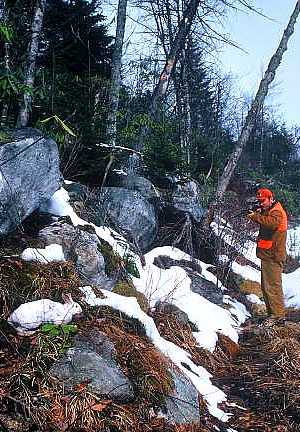
Sleet and snow stung my face. A foot of powder covered the ground and the wind whipped through the spruce forest. For a moment I let my thoughts drift to the low country, where spring was on its way. Here at 4,500 feet, however, winter showed no sign of retreat.
The bay of hounds suddenly reminded my frigid fingers why we were there. I was accompanying Bob Beahm, former school principal turned hunting guide, and his skilled beagles on a hunt for snowshoe hares.
The dogs were hot on the trail of a bounding white rabbit, and their howls were growing closer. Spreading out in the dense spruce forest, we set up an ambush, silently waiting for the hare to circle. Before long, I spotted him, slipping cautiously beneath the green boughs. He looked huge—almost surreal as he hopped across the powder on his oversized feet. Taking aim quickly, I squeezed the trigger and was soon admiring the soft white fur of a handsome hare.
The snowshoe hare—or varying hare— is an intriguing animal that can be found throughout vast stretches of the northern U.S. and Canada. Hunting in West Virginia’s Allegheny Mountains, we were pursuing them in the southernmost extremity of their range.
Hares are only lightly pressured in most areas, so long seasons are typically allowed. In Michigan, for instance, hunting extends through March 31. In Wisconsin, there is no closed season or bag limit.
 |
| A snowshoe’s coat and large padded feet allow it to thrive throughout frigid stretches of the northern U.S. and Canada. |
This means hares can often be hunted long after deer and elk seasons have closed. They offer a welcome escape during dreary months and are a great cure for even the worst cases of cabin fever. Whether you own crackerjack beagles or just want to go out with a friend and jump a few hares, it’s fairly simple to have a fun and productive hunt.
Where to Hare
Check with local wildlife biologists and game wardens to zero in on hunting opportunities. Look for areas with an abundance of snow and strong hare populations. Once you have a location in mind, begin focusing on specific types of vegetation hares prefer.
In the North, look for species such as balsam, cedar, fir, spruce and pine. Young, low-growing trees are particularly favored. Locate this evergreen growth near food sources such as willow, birch, aspen and alders, and you’ve found a likely hare paradise.
If you’re hunting in the Mid-Atlantic, concentrate on high elevation areas—over 3,000 feet. Be sure to pinpoint stands of red spruce, rhododendron, laurel and high brush cranberry.
Follow those Feet
Once you pinpoint a promising spot, it’s easy to tell if the white rabbits are there. Fresh tracks will give them away. Search for prints similar to a cottontail’s, but much larger. Hares tend to beat down regular runways, and if you find those, you know you’ve struck pay dirt. The bigger and deeper the runways are, the more hares in that area.
You can hunt hares a number of ways. Some like to still hunt through the woods with a .22 rifle, like a miniature deer hunt. This is a fun and exciting tactic.
For most of my hare hunting, I use two approaches, both involving shotguns. Any gauge from 12 to 20 will work. I suggest using size 4, 5, or 6 shot.
The first approach is to release trained hounds and let them chase the hares in a circle past waiting hunters. The second technique involves slipping through their habitat and trying to jump shoot the white rabbits.
Release the Hounds!
When dogs push out a hare it typically runs in large circles and swings back close to where it first jumped. Once a fresh track is found or the hounds locate a hare, hunters should spread out, covering the areas where the snowshoe jumped and nearby runways. Knowing where the others in your party are stationed is important and wearing blaze orange is vital. Always be aware of your target and what is beyond it before pulling the trigger.
Listen for the hounds drawing closer and watch intensely. Sometimes you’ll see two or three hares headed your way. Staying still is crucial at this point, or the quarry may flare and take an even wider circle. Raise your gun slowly when you see a hare, but don’t hesitate when taking the shot.
Jumping ‘Shoes
 |
| Jump shooting is a strategy that requires stealth, patience, and a quick trigger finger. |
For the second tactic, jump shooting, tote an open-choked or improved cylinder shotgun. Work slowly through prime cover, trying to roust your quarry. You have to be ready to take a quick shot before it disappears. Shoot fast, squeezing the trigger as the barrel pulls past the hopping white form.
If you spot a hare too far to shoot, you may be able to close the distance diagonally and get into range. Don’t walk straight towards it, or the hare will spook and flee. The best jump shooting occurs when there is fresh snow on the ground and you can slink through the woods like a lynx.
No matter which tactic you choose, hunting snowshoe hares is an exciting challenge. It also provides an opportunity to get off the couch and learn more about the land. Be careful though, this cabin fever cure has a tendency to become a full-on obsession!
For more information on still hunting tactics be sure to check out “Showshoe Hares the Hard Way.”
- 6466 views


